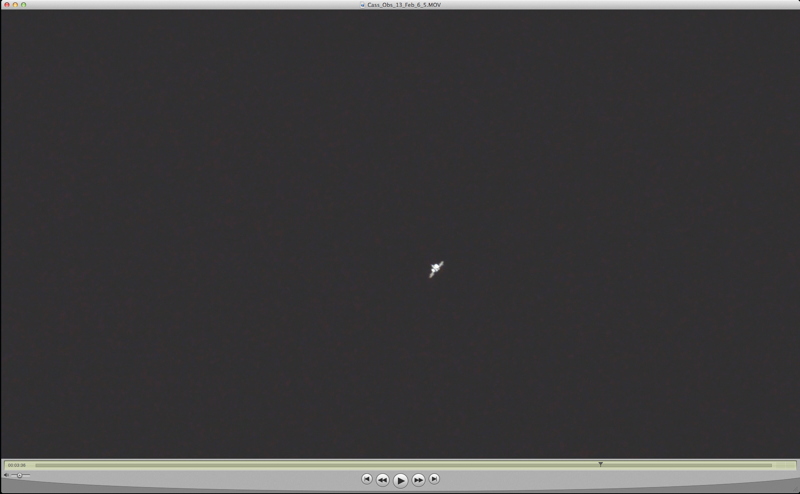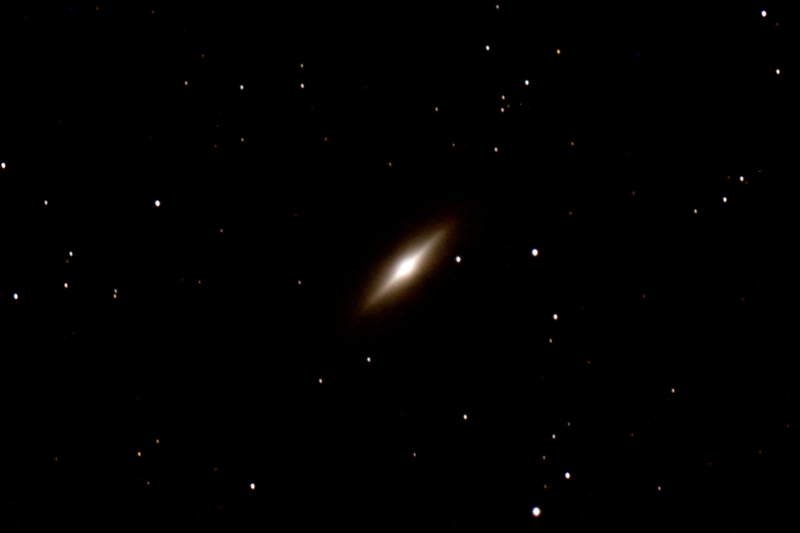
Mars/Mercury, ISS, Trapezium Spectra, Jupiter,
NGC3115 Galaxy
Posted: 7 February 2013
Wednesday, 6 February 2013, had partly cloudy skies most of the daytime. As sunset approached, the skies began to clear. The observatory was opened at 1804 MST, 65°F. This was going to be a busy night. I had expected 6 visitors (but they had to cancel out after the session began). And there was all the imaging I planned to do. At 1809 MST, viewed Mercury, 77X and 206X. Phase was almost half. I then updated the ISS TLE parameters for the night's good pass.
At 1821 MST, viewed Mars and Mercury with 7x50 binoculars. They are getting closer together as they approach their very close conjunction on 8 February. At 1822 MST, I was able to see both planets with the naked eye. At 1838 MST, I took this photo of Mars (top) and Mercury (bottom) with the D7000 DSLR, f/4.8, 1/20sec, ISO 400, 145mm:

At 1858 MST, as I began getting ready to image the ISS, I noticed that the Zodiacal Light was just becoming visible high in the sky (away from the still bright western horizon).
I mounted the D7000 DSLR at prime focus of the 8" LX200-ACF and at 1900 MST, I did a focus test with the Bahtinov Mask using the star Sirius. I adjusted the finderscope alignment to match the camera's field-of-view (FOV) and locked the telescope focus. All was ready for the ISS at 1910 MST. The pass was scheduled to begin at 1920 MST, but it became visible earlier than that. As a result, tracking was not very good. Fortunately, there were some pretty good frames in the HD video recording, 1/2500sec, ISO 2000. This frame from near the highest portion of the pass, and hence its closest to the observatory, shows the size of the International Space Station in the FOV:

This image is a compilation of several views of the ISS from about midway in the pass to its best high overhead, upscaled slightly:

After the ISS pass was over, I set up for some spectra imaging of the Trapezium star cluster in Orion using the Star Analyzer at prime focus + 3X TeleXtender. This (overexposed) image, 2 seconds, ISO 2500, shows the Trapezium at the left with the spectra of the stars at the right:

The image above is tracked. I made several attempts at capturing the spectra using the drift method, but unfortunately, the spectra all overlapped due to the closeness of the stars.
At 1954 MST, I saw that clouds were increasing. At 2022 MST, I set up for Jupiter imaging at prime focus + 3X TeleXtender. This is a stack of 1389 frames from an HD video recording, 1/60sec, ISO 1600, and upscaled 200%:

I completed imaging at 2029 MST. I spent some time viewing Jupiter at 206X and 364X. The view of the cloud bands was good. I tried 619X and 1091X, but that was too much magnification for good viewing (the theoretical maximum magnification for the 8" is about 400X). However, 412X provided good views of Jupiter. I then viewed Jupiter at 77X; three moons were visible. The temperature was now 48°F and the humidity at 50%.
At 2125 MST, slewed to NGC3115 (Spindle Galaxy). It was still in the tree to the east. I began preparing the camera for prime focus + off-axis guider imaging. At 2206 MST, viewed NGC3115 at 77X. The view of the galaxy was good, especially with averted vision. At 2217 MST, I did a focus test on the star Regulus with the Bahtinov Mask, followed by two framing test exposures of NGC3115 as I searched for a good guide star. With a faint guide star located, I captured this guided image (slightly cropped from full-frame) of NGC3115 (Spindle Galaxy), 5 minutes, ISO 6400:

At 2236 MST, clouds were now in much of the sky, so I decided to end the session. I closed the observatory at 2253 MST, 48°F.
Comments are welcome; use the Comments section below, or you can Email Me. Thanks.
Go to the previous report.
Return to the Cassiopeia Observatory Home Page.